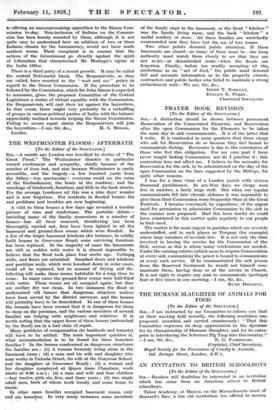THE WESTMINSTER FLOODS : AFTERMATH
[To the Editor of the SPECTATOR]
Snt,—A month ago London was horrified by stories of " The Great Flood." The Westminster disaster in particular roused excitement and sympathy, chiefly because of the number of lives lost, and also because Westminster is easily accessible, and the tragedy—a few hundred yards from the Abbey—Was spectacular : everyone could see the ruins of the Embankment, the boats in the roadway, and the wreckage of brickwork, furniture, and filth in the back streets. For the average Londoner all this was a nine days' wonder and is now forgotten. For residents in flooded houses the real problems and troubles are now beginning.
A visit to these houses a few days ago revealed a terrible picture of ruin and misfortune. The portable debris— including many of the family possessions in a number of houses—has all been removed, disinfecting has been thoroughly carried out, fires have been lighted in all the basement and ground-floor rooms which were flooded. In a few of the larger basement kitchens (for instance, in solidly built houses in Grosvenor Road) some surviving furniture has been replaced. In the majority of cases the basements are still so sodden with water it is almost impossible to believe that the flood took place four weeks ago. Ceiling's' walls, and floors are saturated. Smashed doors and windows and partition walls, which were knocked down in some cases, could all be replaced, but no amount of drying and dis- infecting will make these rooms habitable for a long time to come. In many cases the ground-floor rooms were half-filled with water. These rooms are all occupied again, but they are neither dry nor clean. In two instances the flood so undermined old houses that dangerous structure notices have been served by the district surveyor, and the houses will probably have to be demolished. In one of these houses the tenants have been warned that it is dangerous for them to sleep on the premises, and the various members of several families are lodging with neighbours and relatives. It is worth noting that the upper floors of these houses (untouched by the flood) are in a bad state of repair.
Many problems of compensation (to landlords and tenants) will have to be settled. The most important question is, what accommodation is to be found for these homeless families ? In the houses condemned as dangerous structures the families are : (1) A woman formerly living alone in the basement room ; (2) a man and his wife and daughter (the man works in Victoria Street, his wife at the Graycoat School, and the daughter at Grosvenor Road) ; (3) a, woman and her daughter (employed at Queen Anne Chambers, work starts at 6.80 a.m.) ; (4) a man and wife and four children —boy twelve, girls- six, five, and three years ; (5) two single adult men, both of whom work locally and come home to meals.
In other cases families occupied basement rooms only and are homeless. In very many instances some members of the family slept in the basement, or the front " kitchen " was the family living room, and the back " kitchen " a useful scullery or store. All these families are wretchedly overcrowded now they have lost the use of two rooms.
Two other points demand public attention. If these basements are closed—as many of them must be—the local authority must watch them closely to see that they are not re-let—at decontrolled rents—when the floods are forgotten. Finally, before too readily accepting all this misfortune as an " act of God," the public must demand full and accurate information as to the property owners, contractors and public bodies who failed to maintain a strong embankment wall.—We are, Sir, &c.,
IRENE T. BARCLAY,
•
EVELYN E. PERRY, Chartered Surveyors.






































 Previous page
Previous page